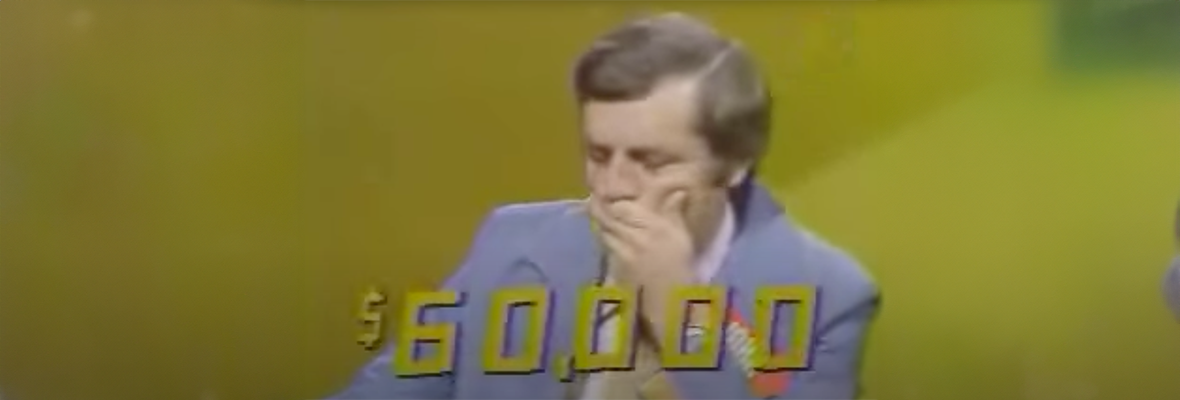
John Hatton: The Master of Blockbusters
Oft-forgotten among game show trivia legends, guest author Jeremy Nelson lays out the evidence of John Hatton's game show greatness.
Television audiences have always flocked to those who are head and shoulders above the rest. Whether you’re Tom Brady or Thom McKee, Ken Jennings or Ken Griffey Jr, sustained excellence almost always leads to comparisons to the greats in your field.
Well, almost.
Of all the game show greats you may have seen, one man who often goes unheralded is John Hatton, champion of the game show Blockbusters. During the show’s 18 month run, he was the only solo player to win $120,000, the show’s maximum take.
Blockbusters was a nifty game show that ran on NBC from 1980-1982, with the kind of premise that seemed in line with the Rubik’s Cube and Trivial Pursuit-crazes of the early 1980s. A solo player competed against a family pair to answer questions and complete a path across a game board of hexagons; the solo player had a path one hexagon shorter to make up for the shorthanded nature of the game.
This meant that from the get-go, John was always competing against two players. Two brains. Two additional buzzers. Imagine how much more difficult it would be to remain Jeopardy champion if your two challengers were sharing a score and conferring on Final Jeopardy clues.

John blasted through the producer’s “Are two heads better than one?” query by winning the maximum 20 matches. Each match was best of three games, and while John won his 40 games to retire undefeated, the 20 family pairs he defeated could only muster 4 wins between them, only earning $2,000 and some lovely parting gifts. But John winning 20 matches was only the tip of the iceberg; his stats proved just how dominant those 20 wins were.
Everything being equal according to the producer’s query, John should have only answered 33%, or ⅓ of the questions correctly. Of the 374 questions asked, John answered 220 of them correctly, taking 58% of the question shares (questions answered correctly divided by total questions asked). By comparison, it’s rare for Jeopardy contestants to reach 30 correct responses in a game, and achieving this milestone almost guarantees you’ll be the champion. But how elite do you have to be to accomplish this feat? The last three contestants to do it were 9 game winner Isaac Hirsch, 15 game winner Adriana Harmeyer, and current Jeopardy Masters titleholder Victoria Groce.
By comparison, During Ken’s original reign, he answered 2,643 clues correctly of a possible 4,500 sans Final Jeopardy, giving him an average of 35.2 clues a game.
That’s 58% of the question shares.
John Hatton was as good at Blockbusters as Ken Jennings was at Jeopardy.
In a game of Blockbusters, the paths the teams must complete are in direct conflict- the solo player completing a vertical path, and the family pair completing a horizontal one, with no way to achieve a tie due to the nature of hexagons. The solo player could win with as few as four right answers, while the family pair could win in as few as five.
John had a quick buzzer hand and the innate ability to anticipate where Blockbusters’ sometimes-tricky questions were heading, and as a result, 16 of John’s 40 wins never made it past the sixth question; in comparison, most games take at least 10 questions to decide a winner. 8 of those 16 games ended with four of John’s red hexagons on the board and nothing else- a complete shutout.
In John’s third match, host Bill Cullen introduced a chipper brother and sister team to the public. Six minutes and eight red hexagons later, John offered a sincere apology as the now-stunned pair were escorted offstage to receive their parting gifts. Watching it back, the match could aptly be compared to watching a UFC fight end in a Round One knockout, with the six minute time only stretched that far thanks to affable host Bill Cullen.
John could lay waste to unsuspecting teams, but the best champions in any arena know how to perform under pressure. On questions where only his opponent had the chance to win, John “blocked” them out 66% of the time, extending the game and often forcing the team to take a longer route to win (or, in most cases, their eventual defeat). On questions where the game came down to one question on which either team could win, John took the question and the game 80% of the time. For someone whose odds of getting a right answer should have been 33%, John’s skill allowed him to flip those odds tremendously.
John didn’t lose games often, but when he did, he often came back with a vengeance. In the four games John played after a loss, he answered 17 of the 26 questions asked correctly for a 65% question share. Two of those games ended in 4-0 shutouts.
The show’s bonus round, the Gold Run, was where the bulk of the money was won; $5,000 for each try by making a horizontal path across the board in 60 seconds. John won every gold run, often only missing one clue, sometimes needing less than 30 seconds to complete his path to victory. He averaged 39 seconds, and had the bonus round only given him 45 seconds, he still would have won 16 times, netting him more than $100,000 and making him the second highest solo money winner behind only Leland Yung ($106,600).
All that said, we can’t talk about John Hatton’s performance under pressure without talking about the fire.
After winning his sixth match, John’s family informed him that their house burned down during the Panorama Fire in San Bernardino. Producers gave him the option to come back and play another day, but not only did John stay and win…he actually got better.
In the 13 games he played before receiving the news, John answered 66 of the 115 questions asked for a 57% question share- right on par with his all-time average. His first game after deciding to stay was an unusually long 16 game affair (John’s games took an average of 8.5 questions to complete), but in the 9 games he played after receiving the news, 5 ended in five or less questions, and his question share increased to nearly 64%. Over those 9 games, most remarkably, he only gave a total of 6 incorrect answers. “Locked In” is an understatement.
Starting his run at the end of the show’s fifth week, John was one of the early winners when the original match limit was ten wins. By September of 1981, that increased to twenty, and John was brought back to play in April of 1982, less than three weeks before Blockbusters aired its final episode. John’s question share during his first run was 58%. During his second reign?
58%.
John’s 20th match provided the most tension- after handily defeating the family pair in Game 1 in just 7 questions, the second game was a back and forth affair, resulting in the only game in 44 in which John answered more questions incorrectly (6) than correctly (4). However, his three early scores in the rubber match forced the family pair into a corner they weren’t able to escape from, resulting in his 20th win. Five gold blocks and 29 seconds later, John Hatton emerged as Blockbusters’ third 20 game winner, the only solo player to win the $120,000 maximum.
It’s somewhat apropos that John nearly served as the bookends for the show, making his first appearance on episode 25 and his final on episode 370, the third to last. Yes, his matches took a little longer than they did during his first reign, and fewer teams were subjected to the Hatton Hit Job (my now-trademarked term for shutout wins) but John’s consistency otherwise never wavered. A contestant who played passionately and strove for excellence in the face of adversity, John Hatton gave Blockbusters 110%, and no stat can top that.
